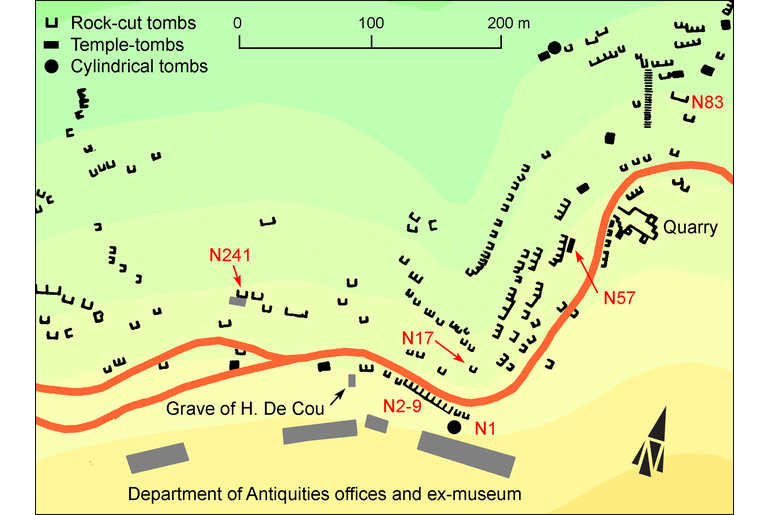Family epitaph
IGCyr028700
Trismegistos ID: 738283
Source Description
Support
White marble stele, reddish from earth, with plain moulding on top (0.29; 0.88;0.25).
Layout
Lines 4 to 9 were probably inscribed first, then lines 10-13 and eventually lines 1-3.
Letters
0.027-0.03.
Place of Origin
Cyrene pleiades; HGL : perhaps North Necropolis .
Date
End of second or beginning of first century B.C. (lettering)
Findspot
Copied by J.-R. Pacho with other epitaphs from the North Necropolis .
Last recorded Location
Seen by G. Oliverio before 1930 in the mid-level plateau below Cyrene pleiades; HGL : at Sidi Omran pleiades; HGL , where it had probably been brought in the meantime.
Present Location
Not seen by IGCyr team.
Text constituted from
Transcription from previous editors (CDL).
Bibliography
CIG Corpus Inscriptionum Graecarum, I-IV, Berlin, 1828-1877 - see in bibliography 5148 from Pacho, 1827 Pacho, J.-R., 1827, Relation d'un voyage dans la Marmarique, la Cyrénaïque et les oasis d'Audjelah et de Maradeh, pendant les années 1824 et 1825, Paris - see in bibliography , pl. LXV.8 and Sardinian consul in Tripoli; SGDI Bechtel, F., Baunack, J., et al., Collitz, H. (ed.), Sammlung der griechischen Dialekt-Inschriften, III.2, Göttingen, 1905 - see in bibliography 4860; Oliverio, 1933-1936 Oliverio, G., 1933-1936, Documenti antichi dell'Africa Italiana, II, fasc. 1-2, Bergamo - see in bibliography , p. 121, n. 131, fig. 86, whence SEG Supplementum Epigraphicum Graecum, Leiden, then Amsterdam, 1923-1971, then 1979- - see in bibliography , 9.243.
Text
Apparatus
1 Πρᾶξις Π [c. 4 - 6] : Oliverio, 1933-1936 Oliverio, G., 1933-1936, Documenti antichi dell'Africa Italiana, II, fasc. 1-2, Bergamo - see in bibliography Πρᾶξις Π[ρα]- : CIG Corpus Inscriptionum Graecarum, I-IV, Berlin, 1828-1877 - see in bibliography Πρᾶξις Τε[λέα?]
2 Θράσος ΑΣ Σω[σάν] (from Oliverio's drawing) : Oliverio, 1933-1936 Oliverio, G., 1933-1936, Documenti antichi dell'Africa Italiana, II, fasc. 1-2, Bergamo - see in bibliography Θράσος Σω[σάν] : CIG Corpus Inscriptionum Graecarum, I-IV, Berlin, 1828-1877 - see in bibliography Πρᾶξ[ι]ς Τι[σάν]
French translation
Praxis fils de P [c. 4 - 6]. Thrasos AS(?) fils de Sosandros, âgé de 70 ans. Autoklès fils d'Aristarkhos. Sôsandros fils d'Autoklès. Praxis fils de Sôsandros. Praxis fils de Néôn. Néôn fils de Néôn.
English translation
Praxis son of P [c. 4 - 6]. Thrasos AS(?) son of Sosandros, 70 years old. Autokles son of Aristarchos. Sosandros son of Autokles. Praxis son of Sosandros. Praxis son of Neon. Neon son of Neon.
Italian translation
Praxis figlio di P [c. 4 - 6]. Thrasos AS(?) figlio di Sosandros, di 70 anni. Autokles figlio di Aristarchos. Sosandros figlio di Autokles. Praxis figlio di Sosandros. Praxis figlio di Neon. Neon figlio di Neon.
Commentary
This stele was inscribed at different times and the latest mentions at lines 1-3 might be of Roman time.
In #fraser-matthews, all names are registered with date I B.C./ I A.D., a date which might apply only to ll. 1-3.
Oliverio's idea that a first mention Πρᾶξις Πρά|ξιος was first inscribed on ll. 1-2 with the letters of l. 2 centered, cannot be ascertained from his drawing. Non liquet .
What seems convincing in Oliverio's drawing and reading at line 2 is the name Thrasos at left and perhaps at the end of the line something that would be the beginning of the father's name ending at line 3: Σω[σάν]|δρω, a name that occurs twice again below and might be traditional in the family. However, there remains a senseless ΑΣ in the middle of line 2.
Creative Commons Attributions-NonCommercial 4.0 International License.
All citation, reuse or distribution of this work must contain a link back to DOI: http://doi.org/10.6092/UNIBO/IGCYRGVCYR and the filename (IGCyr000000 or GVCyr000), as well as the year of consultation.
